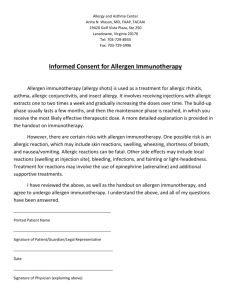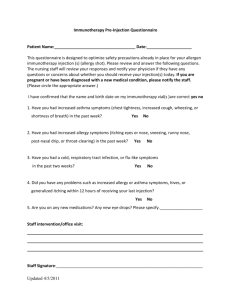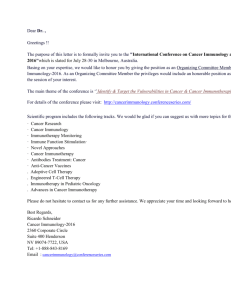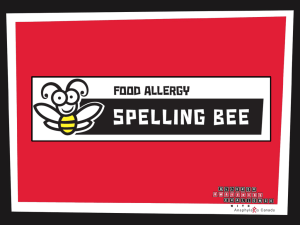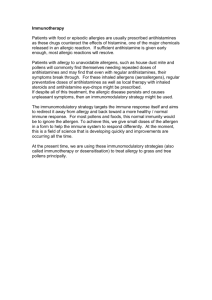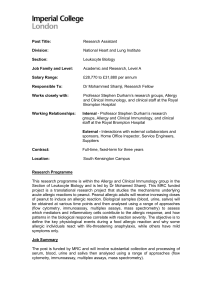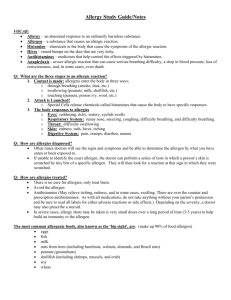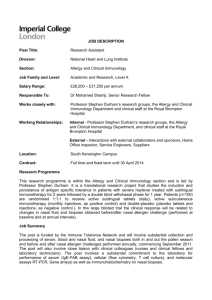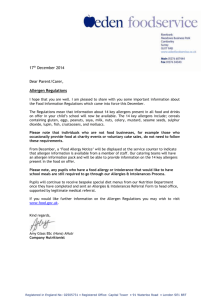Allergen Immunotherapy 2/22/2016 Nathanael Brady, D.O.
advertisement
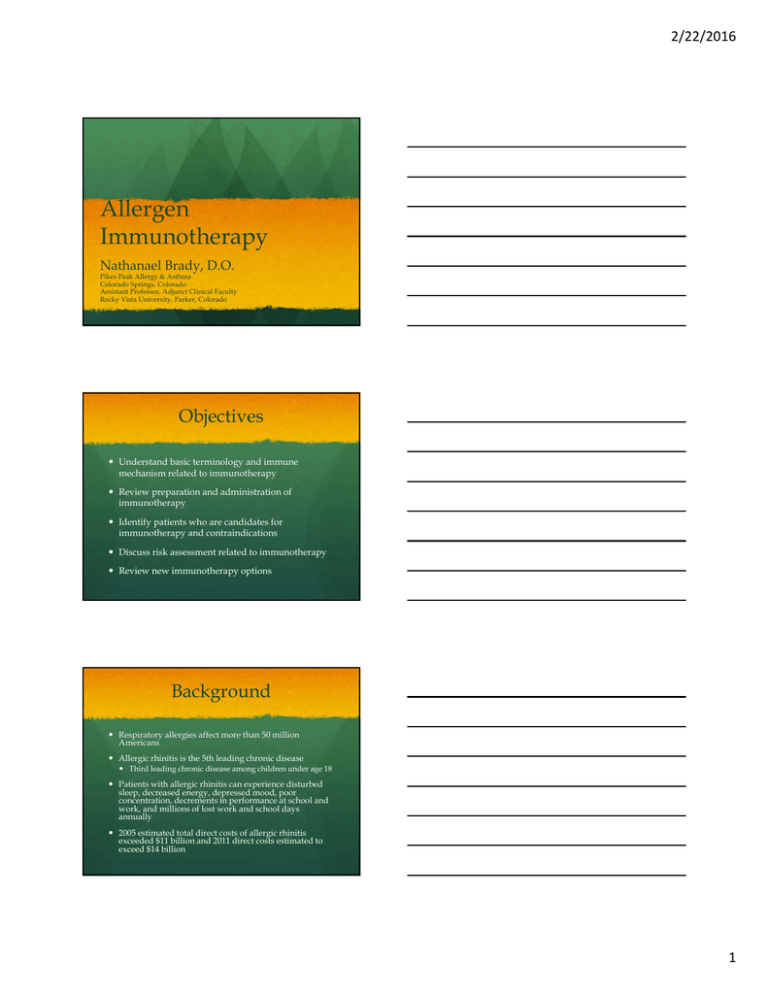
2/22/2016 Allergen Immunotherapy Nathanael Brady, D.O. Pikes Peak Allergy & Asthma Colorado Springs, Colorado Assistant Professor, Adjunct Clinical Faculty Rocky Vista University, Parker, Colorado Objectives Understand basic terminology and immune mechanism related to immunotherapy Review preparation and administration of immunotherapy Identify patients who are candidates for immunotherapy and contraindications Discuss risk assessment related to immunotherapy Review new immunotherapy options Background Respiratory allergies affect more than 50 million Americans Allergic rhinitis is the 5th leading chronic disease Third leading chronic disease among children under age 18 Patients with allergic rhinitis can experience disturbed sleep, decreased energy, depressed mood, poor concentration, decrements in performance at school and work, and millions of lost work and school days annually 2005 estimated total direct costs of allergic rhinitis exceeded $11 billion and 2011 direct costs estimated to exceed $14 billion 1 2/22/2016 Terminology Allergen Immunotherapy Allergen extract Solutions of proteins extracted from source material (pollen, mold culture, and pelt) not yet incorporated into a therapeutic extract Build-up phase Repeated administration of specific allergens to a patient with IgE-mediated conditions with the goal of providing protection against inflammatory reactions and allergic symptoms Receiving injections containing increasing amounts of allergen Aka: up-dosing, induction, or dose-increase phase Maintenance concentrate Extract that contains therapeutic effective doses for each individual constituents Dilutions should be reference to maintenance Terminology Desensitization Rapid administration of increasing doses of allergen to render effector cells less or nonreactive to an IgE-mediated response Local reaction Manifest as redness, puritus, and swelling at injection site Cluster immunotherapy Accelerated build-up schedule, multiple injections given on single day Maintenance dose achieved more rapidly Rush dosing – multiple injections given over 1-3 days to reach target dose Associated with higher risk of systemic reactions Allergen Immunotherapy (AIT) Allergen immunotherapy (AIT) effective treatment for: Allergic rhinitis Allergic conjunctivitis Allergic asthma Hymenoptra venom allergy All ages with systemic reaction and limited skin reactions in those at least 16 years old Potential for frequent/disabling large local reactions Possibly for atopic dermatitis Beneficial in adults & children No absolute lower or upper age limits Only disease modifying treatment 2 2/22/2016 Candidates for immunotherapy Symptoms not controlled by medication/avoidance measures Unacceptable medication adverse effects Desire to reduce long-term medication use Goal for long-term efficacy Pregnancy May be continued but usually not initiated in pregnant patient Decision Factors Patient’s preference/acceptability Adherence Response to avoidance measures Medication requirements Lost productivity, ED/UC or office visits Quality of life including sleep Additional benefits in children Prevention of additional sensitization for those with fewer baseline sensitizations Prevention of asthma development in patients with allergic rhinitis 3 2/22/2016 Preparation Individually prepared for each patient Allows customized treatment specific to patient’s sensitizations Reduces the risk of cross-contamination Reduces patient identification errors Standardized prescription & administration forms Improves safety, uniformity, and standardization Administration 26 to 27-gauge syringe with ½ or 3/8-inch needle Posterior portion of the middle third of arm, junction of deltoid and tricep muscles Adjustments New vial Missed injections Post-reactions During sensitive pollen seasons 4 2/22/2016 Immunologic Response Generation of regulatory T cells which produce inhibitory cytokines Initial increased specific IgE levels then gradual decline Specific IgG1, IgG4, & IgA increase Not consistently correlated to clinical improvement Increase in allergen-specific IgG levels aren’t predictive of degree or duration of immunotherapy efficacy Immunologic Response Later/delayed deviation from Th2 to Th1 cytokine profile Decreased sensitivity of end organs (conjunctiva, skin, respiratory mucosa) both immediate and delayed responses Decreased eosinophils and mast cells in respiratory mucosa & secretions 5 2/22/2016 Risk Assessment Baseline individual risk assessment factors Poorly controlled asthma Previous systemic reaction Concomitant B-blocker use Administration in unsupervised setting Co-morbid illness (e.g., cardiac, pulmonary) Pregnancy High allergen sensitivity Baseline serum tryptase (venom IT) Risk Assessment Local reactions Fairly common, not predictive of systemic reactions Systemic reactions Incidence 1 in 500 to 1 in 1000 (0.1-0.2%); 2-5% of patients 8 million injection visits/year Conventional (non-accelerated) buildup Most severe reactions occur within 30 minutes of injection Fatality risk 1 in 2,500,000; 40% occur in facility w/o physician present Delay of epinephrine administration None reported in most recent survey (2008) Risk Assessment “Regardless of the location, allergen immunotherapy should be administered under the direct supervision of an appropriately trained physician, qualified physician extender, or in a facility with the appropriate equipment, medications, and personnel to treat anaphylaxis” Consistent with allergen extract package insert’s black box warning 6 2/22/2016 Efficacy Objective measures are not routinely used clinically Skin test reactivity or IgE levels do not correlate closely to patient’s clinical response Medication use and clinical symptom scores beneficial Subjective assessments are most often relied upon Patients overall improvement Symptoms during allergy season Quality of life Caution with placebo effect Follow-up and Duration Clinical improvement should be seen very shortly after reaching maintenance dose If improvement not evident after 1 year maintenance, evaluate factors contributing to lack of efficacy Continued exposure to high allergen levels (pet in home) Exposure to non-allergen triggers (e.g., tobacco smoke) Incomplete identification of relevant allergens Inadequate dose of allergen Follow-up every 6-12 months Assess efficacy & compliance, determine adjustments or discontinuation Duration 3-5 years recommended Alternative Uses Investigational Food hypersensitivity Contraindicated Urticaria Angioedema 7 2/22/2016 Non-injection Routes Sublingual (SLIT) Effective in treatment of allergic rhinitis and allergic asthma Currently only FDA-approved use is for grass pollen and ragweed pollen sensitized individuals with allergic rhinitis Approved 2014 Grass – Grastek & Oralair Ragweed – Ragwitek Local reactions, primarily oral-mucosal, are common; systemic reactions rare Market is 45% of specific IT in Europe Non-injection Routes Intranasal Studies show improved symptoms with use for pollen and dust mites Local reactions common & primary reason for most discontinuations Intralymphatic 3-injections comparable efficacy as 3 years conventional IT (non-controlled study, 165 pts) Epicutaneous Fewer symptoms than placebo but no difference in nasal provocation score (grass patch 48hr/wk x 12 wks) Conclusions Allergen immunotherapy is an effective and overall safe therapy for patients with numerous types of atopic disease Candidates eligible for immunotherapy should be informed of possible risks and benefits of therapy Therapy should be managed by a physician knowledgeable with the underlying mechanism and only administered under medical supervision 8 2/22/2016 Questions, Comments, Clarifications… Resources Allergen Immunotherapy: A Practice Parameter Third Update. The Journal of Allergy and Clinical Immunology; January 2011. Allergen Immunotherapy: Clinical Outcomes Assessment. The Journal of Allergy and Clinical Immunology: In Practice; March/April 2014. Course Description Environmental allergies are becoming more prevalent and can be challenging for the medical provider. Allergen immunotherapy offers an effective therapy for many patients. This lecture is intended to help providers understand the mechanism of this therapy and what patients may and may not be candidates. 9
